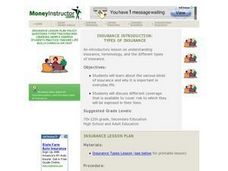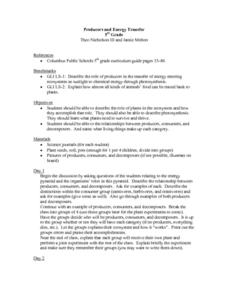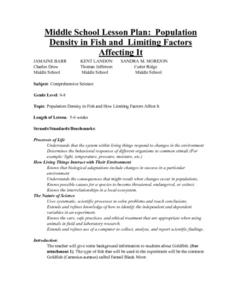Curated OER
Inventions 2: The Impact
Students see what inventors have to think about when making an invention, particularly the kinds of effects they can have on people.
Curated OER
Insurance Introduction: Types of Insurance
Students explore the various kinds of insurance and why it is important in everyday life. They discuss different coverage that is available to cover risk to which they be exposed in their lives.
Curated OER
Texture: Wild Things
Students experiment with different kinds of marking techniques. They read "Where the Wild Things Are" and observe animals for pattern and line. They compare illustrations with Haring's images. They create a symbolic drawing of animal.
Curated OER
Sediment Deposition Lab
Learners set up a stream table, observe erosion, and record data on where various sizes of sediments settle. They draw conclusions as to what kind of sedimentary rock form in what locations.
Curated OER
Insulators, Conductors, and Energy Transfer
Third graders conduct experiments to determine what types of material make good insulators. They prepare a graph of time vs. temperature for their sample. They choose a graph using each kind of material to display for class analysis and...
Curated OER
Mixed Breed Animals Art
Students create an animal in the tradition of medieval animal combinations. They choose components from various animals and design a new animal from those parts. Students draw their animal with careful attention to surrounding...
Curated OER
Tadpoles
Young scholars examine tadpoles at various stages of development. They make careful scientific observations and compare the changes that occur at five different phases of a frog's life.
Curated OER
Banking Account Options
Students explore and discuss the various account options available to them at the bank. They create a paragraph stating the pros and cons of each kind of banking account. This lesson plan is intended for students acquiring English.
Curated OER
What Beautiful Caterpillars!
Second graders investigate the life cycle of the caterpillar. They create a caterpillar habitat and care for it. Students make daily observations that are recorded in a writing journal. During the process of observation the students...
Curated OER
Kids & Computing Don't Crash Your Body With Your Computer
Students listen to two lectures about being healthy and including movement in their day. Students are encouraged to get away from the computers and move their bodies. Careful adjusting of the computer workstation is emphasized to prevent...
Curated OER
Producers and Energy Transfer
Fifth graders discuss the relationship between producers, consumers, and decomposers as they look at the energy pyramid. While working in small groups, they create an ecosystem that includes all or some of the given categories, and they...
Curated OER
Population Density In Fish
Students investigate how a population of fish multiplies in an ecosystem and the kinds of things that must be done to maintain a healthy population balance with other organisms that live there. They conduct an experiment to test the...
Curated OER
Ecosystems II
Students engage in a lesson that is about the concepts related to the careful balance of an ecosystem. They identify the beneficial and harmful relationships that can exist with diverse populations in an ecosystem. The lesson includes...
Curated OER
Collecting and Pressing Plants
Students engage in a lesson that is concerned with the study of native plants and classifying them according to a kind. They press them into a journal while identifying them according to species. Students compile the samples into a...
Curated OER
Warning signs
Students sort and classify different attributes of warning signs, labels, and sounds. In this warning signs lesson plan, the teacher shows students different warning signs, labels, and sounds and tells students what each one means. ...
Curated OER
A Fish Tale Fable
Students identify the moral in a fable. In this folktale lesson, students read an included book, Fish Tale, and identify the message in the book. Students discuss what kind of lessons can be learned from reading this fable.
Curated OER
Good vs. Evil
Make a study of good and evil by examining a short legend. After reading, learners compose their own stories and participate in a class discussion about the text, the characters, and the message of the reading.
Nemours KidsHealth
Empathy: Grades K-2
Second graders read articles about being afraid, dealing with anger and apologizing. For this feelings lesson, 2nd graders read articles and discuss the feelings they have. Students describe their feelings and how to be supportive of...
Curated OER
Happy Faces
Students demonstrate empathy. In this character education lesson plan, students read the book Alexander and the Horrible No Good Very Bad Day and discuss examples of bad days they have experienced. Students are given happy face cut-outs...
Curated OER
Positively Paper
Students study concepts related to paper recycling. In this recycling lesson, they investigate the chemical processes used to recycle paper, and look at the environmental problems associated with using and recycling different types of...
Curated OER
Where Are The Dinosaurs?
Young scholars study the existence of dinosaurs as a precursor to learning about extinction. In this dinosaurs lesson, students watch dinosaur video at assigned web sites. They discuss what they observed in the videos including how the...
Curated OER
Character Ambassadors
Students act as ambassadors. In this character education instructional activity, students take on the roles of ambassadors of the character traits listed. Students write essays regarding the character traits they select.
Curated OER
Altruism: Meeting Society's Needs
Students study society's needs and altruism within communities. For this altruism lesson, students identify and categorize the basic needs that human beings have and define altruism. Students complete research on altruistic organizations...
Curated OER
Philanthropists: Past, Present, Future
Students examine an antislavery activist and their philanthropist ways. They research modern philanthropy and foundations. They create their own kindness plan to execute.

























